(Qinding) Qianlu (欽定)錢錄 "(Imperially endorsed) Book of coins" was compiled on imperial order under the supervision of Liang Zhizheng 梁詩正 (1697-1763) and Jiang Fu 蔣溥 (1708-1761) during the high Qing period 清 (1644-1911).
The catalogue with a length of 16 juan was presented to the throne in 1750. The most significant part of the book narrates the monetary policy from the time of the mythological emperor Fu Xi 伏羲 to the end of the Ming dynasty 明 (1368-1644). Juan 14 gives an overview of foreign coins, chapter 15 lists a lot of specific terms of coins casting through the ages, and juan 16 talks about charm coins that were used to avert evil (yanshengqian 厭勝錢). The figures of coins in this book were all reproduced on the base of the coins collected by the Imperial Household Department (neiwufu 内務府). Inscriptions and patterns, as well as the sizes, are therefore exactly reproduced. The book is helpful for the assessment of the authenticity of coins.
There was an old print from the Imperial Household Department that had been reproduced in the series Siku quanshu 四庫全書 and Mohai jinhu 墨海金壺.
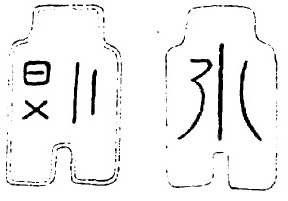 |
Coin allegedly coming from the mythological time of Fu Xi 伏羲. The inscription is interpreted as Di Hao 帝昊, another name of Fu Xi (left) and 幕 or 羲 (right). |
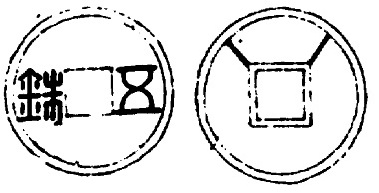 |
Five-zhu 五銖 coin from the time of Emperor Ling 漢靈帝 (r. 167-188). Coins with this denomination were very widespread during the Han period 漢 (206 BCE-220 CE). Zhu is actually a weight unit (see weights and measures). |
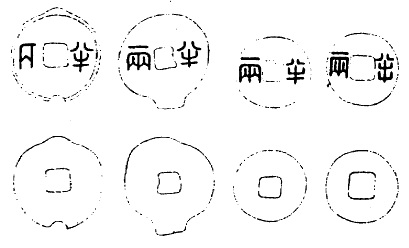 |
Set of half-liang 半兩 coins from the very early Western Han period. Liang is also a weight unit, corresponding to eight zhu. The half-liang coins are therefore sometimes also called four-zhu 四銖 coins. Interestingly enough, the character 兩 of the inscription of the coin to the far left is only shown half, representing half a liang. |
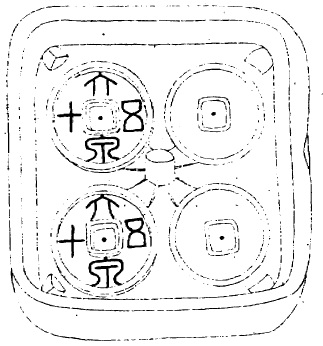 |
Coin mould from the time of the usurper Wang Mang 王莽 (r. 8-22 CE). The inscription reads 大泉五十 "50 large [cash] from the [Imperial] mint". Coins of this denomination were only known during the rule of Wang Mang. |
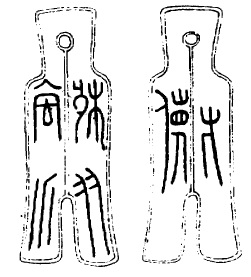 |
Spade-shaped coin from the time of the usurper Wang Mang who planned to reintroduce old administrative patterns from the Zhou period 周 (11th cent.-221 BCE). The characters are very strange and have been disputed by ancient scholars like Hong Zun 洪遵 and Li Xiaomei 李孝美. The character on the right might read Huo bu 貨布 "Spade coin for commerce". |
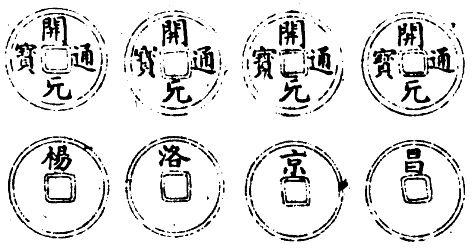 |
Set of coins from the reign-period Kaiyuan 開元 (713-741), the Kaiyuan tongbao 開元通寳. This is the most widespread type of coin from the Tang period 唐 (618-907). Each coin is marked on the backside with a different character, indicating the place of the mint. |
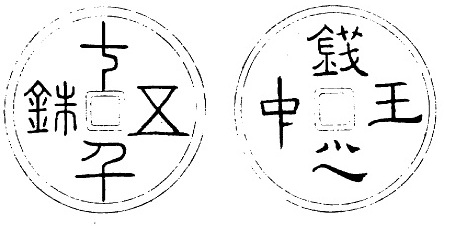 |
Very exceptional large coin (da qian 大錢) from the Tang period, inscribed with Wu zhu qi (shi) qian 五銖七(or 十)千 "five zhu (weight) with a value of 7,000 (or 10,000)" (left) and Zhong wang zhi qian 中王之錢 "money cast by Wang the Middle" (right). |
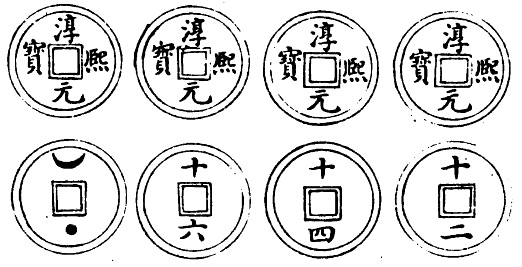 |
Set of coins from the reign-period Chunxi 淳熙 (1174-1189), the Chunxi yuanbao 淳熙元寳. This is a very widespread type of coin from the Song period 宋 (960-1279). Each coin is marked on the backside with a different number or mark, indicating the place of the mint. |
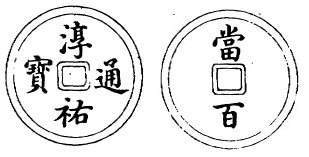 |
Large coin from the Song period, the Chunyou tongbao 淳佑通寳 from the Chunyou reign-period 淳佑 (1241-1252). This is a heavy copper cash with a face (back side) value of 100 small copper cash (dang bai 當百). |
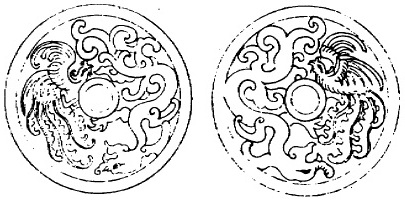 |
Charm coin with the image of a phoenix. |
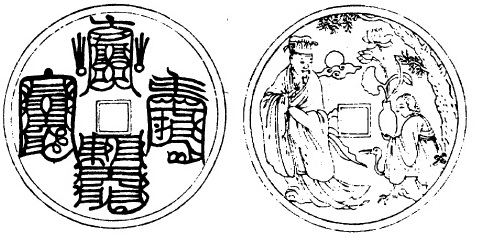 |
Charm coin with talisman characters on the one side and a picture of immortals on the back side. |
There was a book with the same title written during the Tang period 唐 (618-907) by Zhang Taizeng 張臺曾. It was relatively brief and had an appendix with illustrations. The book focused on various types of the five-zhu coins 五銖錢. The book is lost, but 28 fragments are quoted in Hong Zun's 洪遵 (1120-1174) book Quanzhi 泉志 from the Song period 宋 (960-1279).